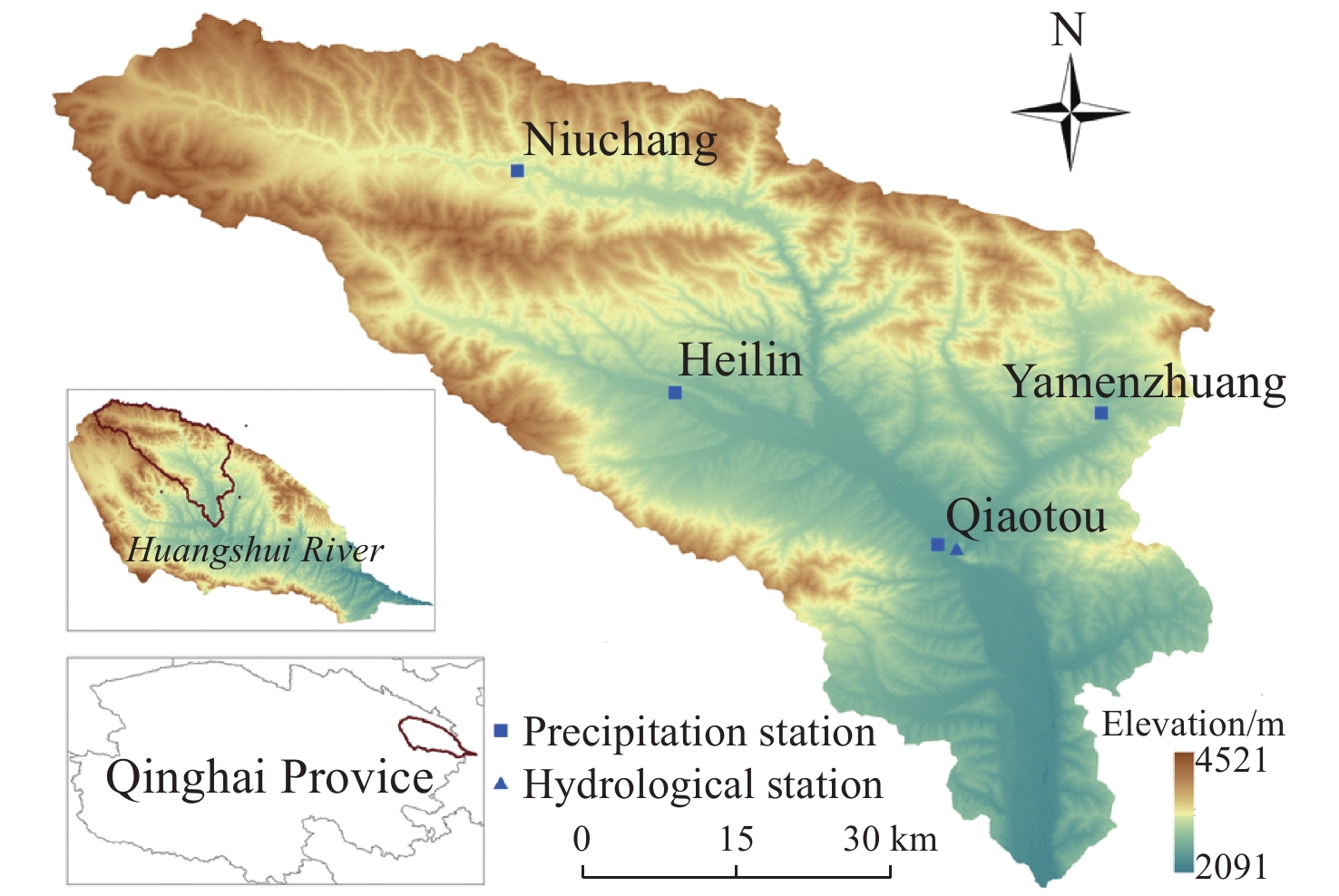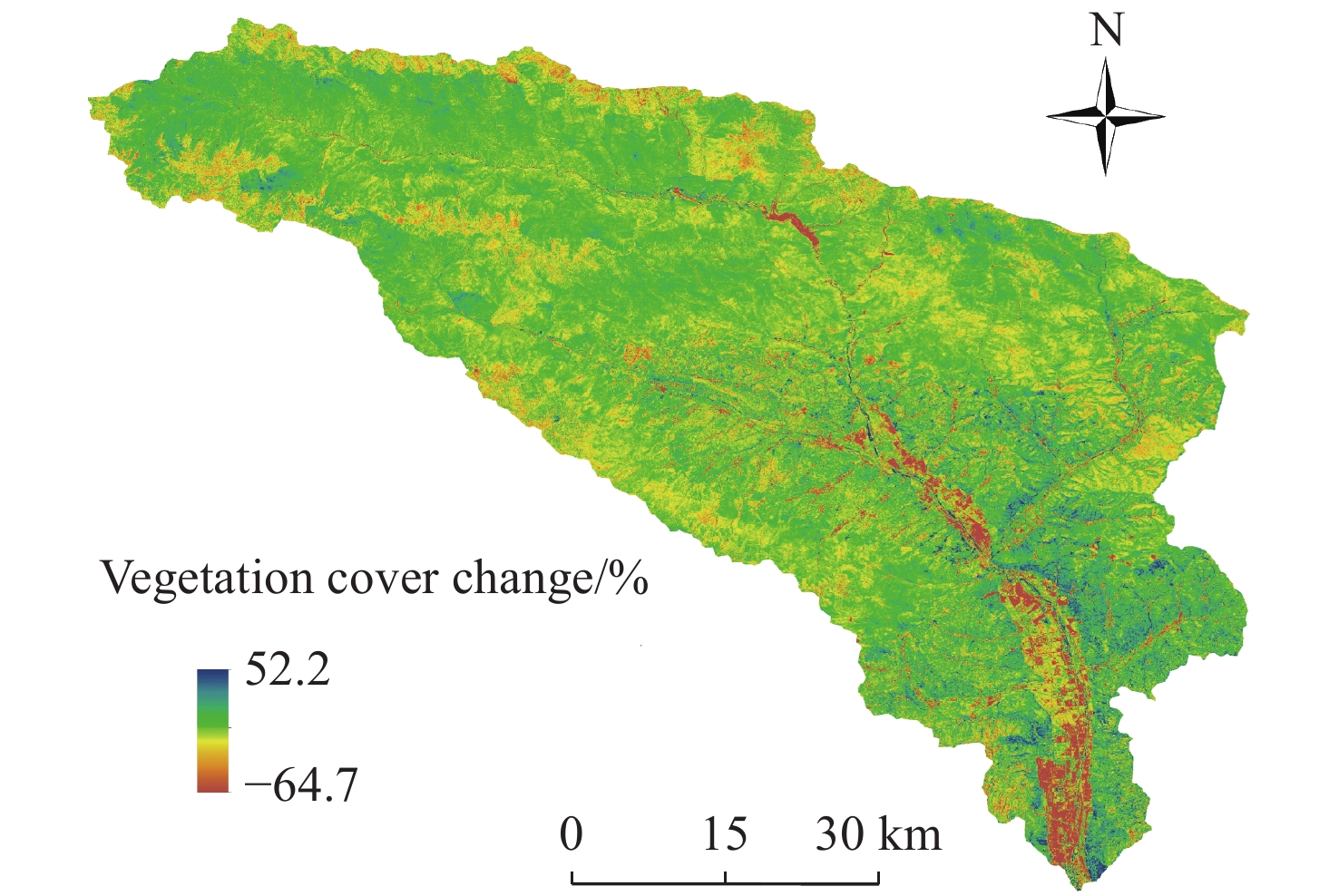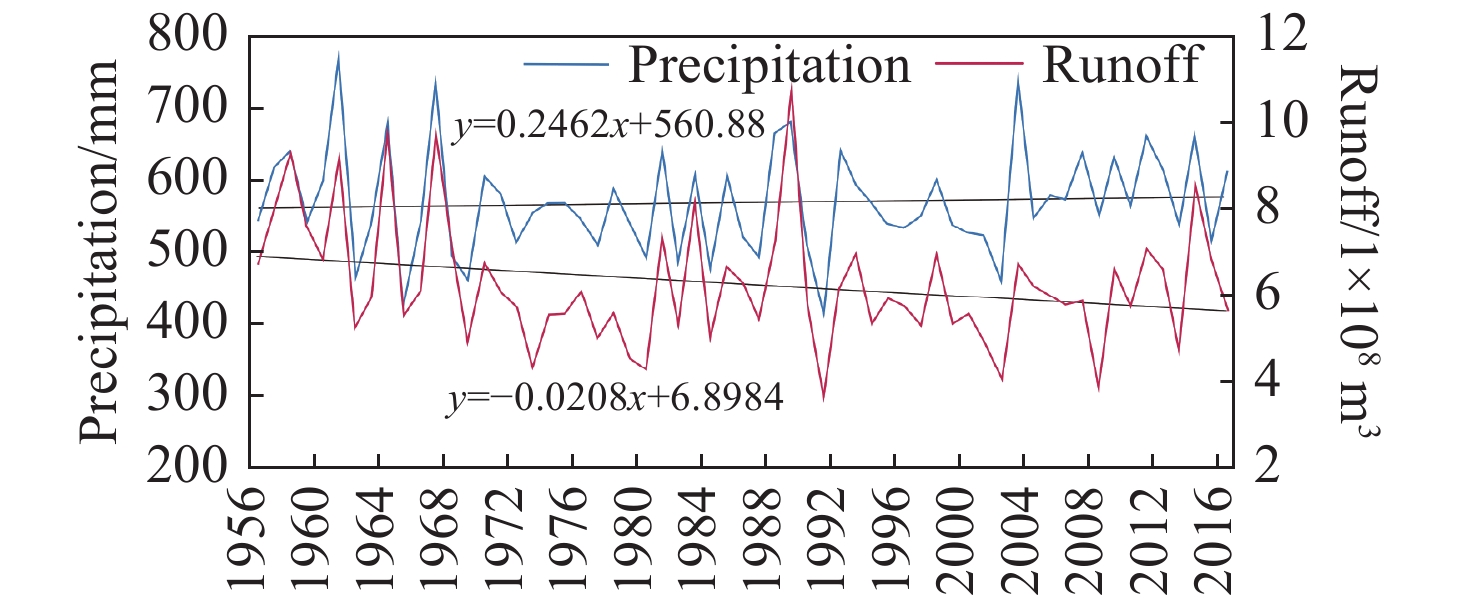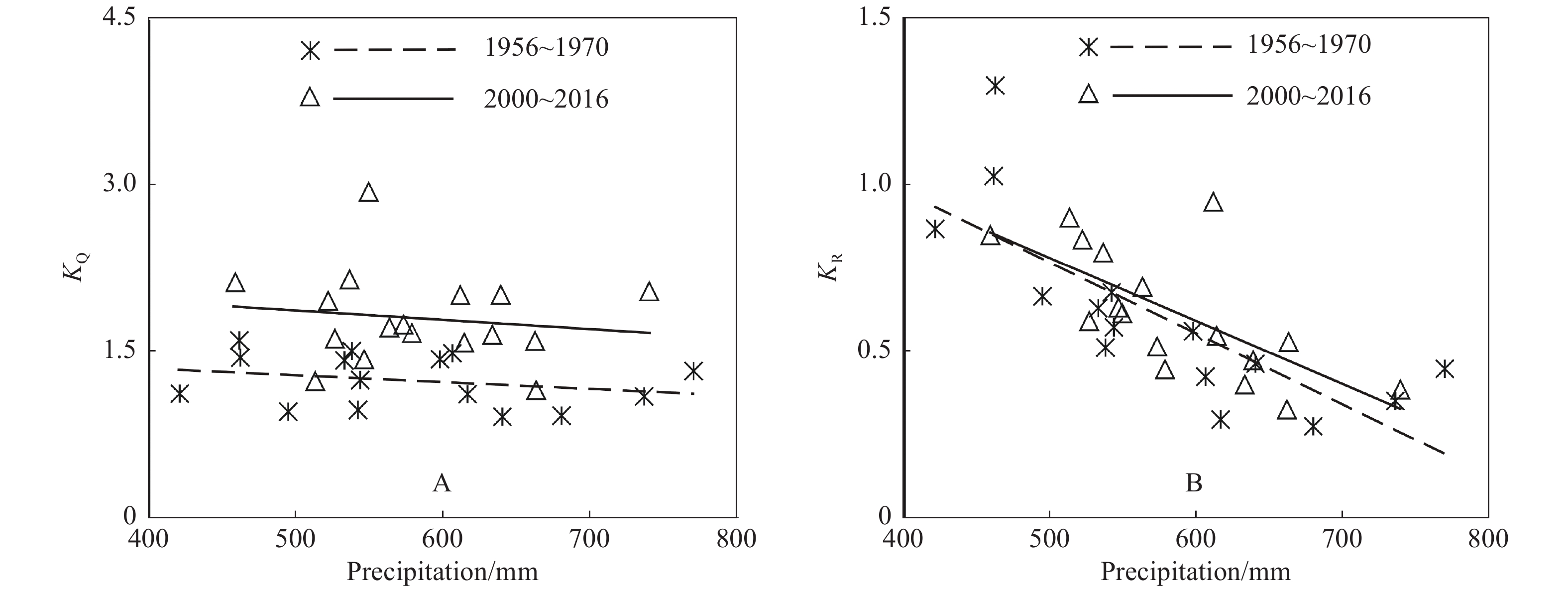Evolutionary trend of water cycle in Beichuan River Basin of China under the influence of vegetation restoration
-
Abstract:
To understand the influence of vegetation restoration on the water cycle in semiarid areas, the effects of vegetation restoration on evolution of the key elements of water cycle were clarified by analyzing the evolutionary trend of atmospheric precipitation, ecological consumption water, and surface runoff on a river basin scale on the basis of analytical results of the changes in vegetation coverage and the long-term meteorological and hydrological monitoring data of Beichuan River Basin. The results show that the vegetation cover in the Beichuan River basin has rapidly increased in the hilly and mountainous areas since the 1980s, especially from 2000 to 2019, with the maximum and average vegetation cover rates increased by 14.98% and 52.2%, respectively. During 1956-2016, the annual precipitation in the basin remained relatively stable; the annual surface runoff slightly declined, with an average attenuation rate of 20 million m3/10a. The main reason for the runoff decline is the increase in ecological water induced by the vegetation restoration, which has changed the spatial-temporal distribution of the water from atmospheric precipitation in the basin. Spatially, more precipitation was converted into ecological water. As a result, the remnant runoff supplied to the lower reaches reduced accordingly. Temporally, more precipitation participated in the soil water - groundwater cycle, thus prolonging the outward drainage period of the precipitation. Moreover, the large-scale vegetation restoration induced a significant decrease in the surface wind speed, evaporation from water surface and drought index. As a result, a virtuously mutual feedback relationship was formed between the vegetation and meteorological elements. Therefore, vegetation restoration is of great significance for the improvement in the water conservation capacity and semiarid climate conditions in the Beichuan River basin.
-

-
Table 1. Statistics of changes in the vegetation cover in the Beichuan River basin according to the data of 2000 and 2019
Range of vegetation coverage (%) 2000 2019 Area (km2) Percentage (%) Area (km2) Percentage (%) <50 51.49 1.53 75.93 2.25 50-60 126.23 3.74 120.88 3.59 60-70 279.86 8.30 222.50 6.60 70-80 991.26 29.41 659.51 19.56 80-100 1 922.15 57.02 2 292.60 68.01 Average 75.32 80.33 Table 2. Statistics of changes in water cycle elements before and after vegetation restoration under the condition of average annual precipitation over the years
Ecological consumption water
(100 million m3)Surface runoff
(100 million m3)Baseflow
(100 million m3)1956-1970 8.92 4.40 2.43 2000-2016 10.03 3.58 2.14 Difference (100 million m3) 1.11 −0.82 −0.29 Change rate (%) 12.4 −18.6 −11.9 -
[1] Chen C, Park T, Wang XH, et al. 2019. China and India lead in greening of the world through land-use management. Nature Sustainability, 2(2): 122-129. doi: 10.1038/s41893-019-0220-7
[2] Chen GC, Zhou LH, Peng M, et al. 2001. Remote sensing interpretation and its characteristics of the forest and shrub vegetation in Huang Shui area, Qinghai Province. Acta Botanica BorealiOccidentalia Sinic, 21(4): 719-726. doi: 10.3321/j.issn:1000-4025.2001.04.021
[3] Chen LD, Huang ZL, Gong J, et al. 2007. The effect of land cover/vegetation on soil water dynamic in the hilly area of the loess plateau, China. Catena, 70(2): 200-208. doi: 10.1016/j.catena.2006.08.007
[4] Eagleson PS. 1978. Climate, Soil, and Vegetation 1. Introduction to Water Balance Dynamics. Water Resources Research, 14(5): 705-712. doi: 10.1029/WR014i005p00705
[5] Gao YX, Liu JC, Feng X, et al. 2019. Experimental study on unsaturated soil water diffusivity in different soils in Hebei Piedmont Plain. Journal of Groundwater Science and Engineering, 7(2): 165-172.
[6] Gashaw G. 2016. Evaluating the effect of climate change and land use/cover change on catchment hydrology of Gumara watershed, Upper Blue Nile basin, Ethiopia. Open Water Journal, 3(1): 1-14.
[7] Hu CH, Zang XM, Zhao Y. 2020. Cause analysis of the centennial trend and recent fluctuation of the Yellow River sediment load. Advances in Water Science, 31(5): 725-733.
[8] Huang TM, Pang ZH. 2011. Estimating groundwater recharge following land-use change using chloride mass balance of soil profiles: A case study at Guyuan and Xifeng in the Loess Plateau of China. Hydrogeology Journal, 19(1): 177-186. doi: 10.1007/s10040-010-0643-8
[9] Huang TM, Pang ZH, Liu JL, et al. 2017. Groundwater recharge in an arid grassland as indicated by soil chloride profile and multiple tracers. Hydrological Processes, 31(5): 1047-1057. doi: 10.1002/hyp.11089
[10] Huang TM, Pang ZH, Yang S, et al. 2020. Impact of afforestation on atmospheric recharge to groundwater in a semiarid area. Journal of Geophysical Research: Atmospheres, 125(9): 1-19. doi: 10.1029/2019JD032185
[11] Li SG, Harazono Y, Zhao HL, et al. 2002. Micrometeorological changes following establishment of artificially established artemisia vegetation on desertified sandy land in the Horqin sandy land, China and their implication on regional environmental change. Journal of Arid Environments, 52(1): 101-119. doi: 10.1006/jare.2001.0983
[12] Liu WZ, Zhang XC, Dang TH, et al. 2010. Soil water dynamics and deep soil recharge in a record wet year in the southern Loess Plateau of China. Agricultural Water Management, 97(8): 1133-1138. doi: 10.1016/j.agwat.2010.01.001
[13] Mark Z. 2019. China's tree-planting drive could falter in a warming world. Nature, 573(7775): 474-475. doi: 10.1038/d41586-019-02789-w
[14] Mattos TS, Oliveira PTSD, Lucas MC, et al. 2019. Groundwater recharge decrease replacing pasture by eucalyptus plantation. Water, 11(6): 1213-1226. doi: 10.3390/w11061213
[15] Mcnaughton KG, Jarvis PG. 1983. Predicting effects of vegetation changes on transpiration and evaporation. Additional Woody Crop Plants, 7(2): 1-47. doi: 10.1016/B978-0-12-424157-2.50007-0
[16] Tesfaldet YT, Puttiwongrak A, Arpornthip T. 2020. Spatial and temporal variation of groundwater recharge in shallow aquifer in the Thepkasattri of Phuket, Thailand. Journal of Groundwater Science and Engineering, 8(1): 10-19. doi: 10.19637/j.cnki.2305-7068.2020.01.002
[17] Wang XY, Bi HX;Gao LB, et al. 2014. Discrimination of factors influencing the runoffs of different spatial scales on loess region in Western Shanxi. Journal of Northwest A & F University(Natural Science Edition), 42(1): 159-166. doi: 10.13207/j.cnki.jnwafu.2014.01.024
[18] Wang YQ, Shao MA, Shao HB, et al. 2010. A preliminary investigation of the dynamic characteristics of dried soil layers on the Loess Plateau of China. Journal of Hydrology, 381(1-2): 9-17. doi: 10.1016/j.jhydrol.2009.09.042
[19] Wu AM, Hao AB, Guo HP, et al. 2020. Main progress and prospect for China’s hydrogeological survey. Journal of Groundwater Science and Engineering, 8(3): 195-209. doi: CNKI:SUN:DXSG.0.2020-03-001
[20] Xu XK, Lin ZH, Xue F, et al. 2003. Correlation analysis between meteorological factors and the ratio of vegetation cove. Acta Ecologica Sinica, 23(2): 221-230. doi: 10.3321/j.issn:1000-0933.2003.02.001
[21] Yan WM, Deng L, Zhong YQW, et al. 2015. The characters of dry soil layer on the loess plateau in China and their influencing factors. PLoS One, 10(8): 1-14. doi: 10.1371/journal.pone.0134902
[22] Zhao CL, Jia XX, Gongadze K, et al. 2019. Permanent dry soil layer a critical control on soil desiccation on China’s Loess Plateau. Scientific Reports, 9(1): 3296. doi: 10.1038/s41598-019-38922-y
[23] Zhao XN, Zhang BQ, Wu PT. 2014. Changes in key driving forces of soil erosion in the Middle Yellow River Basin: vegetation and climate. Natural Hazards, 70(1): 957-968. doi: 10.1007/s11069-013-0849-x
[24] Zhou S, Yu BF, Zhang Y, et al. 2018. Water use efficiency and evapotranspiration partitioning for three typical ecosystems in the Heihe River Basin, northwestern China. Agricultural and Forest Meteorology, 253-254, 261-273.
-




 下载:
下载:








